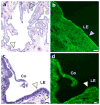Interaction of the conceptus and endometrium to establish pregnancy in mammals: role of interleukin 1β
- PMID: 22382391
- PMCID: PMC5069968
- DOI: 10.1007/s00441-012-1356-1
Interaction of the conceptus and endometrium to establish pregnancy in mammals: role of interleukin 1β
Abstract
Implantation and the establishment of pregnancy in mammals involves an intricate interplay of hormones, cytokines, growth factors, proteins, lipids, ions and the extracellular matrix between the uterine epithelium, stroma, immune cells and the conceptus trophectoderm. The divergent nature of implantation in the mouse, human and pig provides not only an interesting contrast in the establishment of pregnancy and early embryonic development but also intriguing similarities with regard to early endometrial-conceptus signaling. An interesting pro-inflammatory cytokine expressed in a number of mammalian species during the period of implantation is interleukin-1β (IL1B). The presence of IL1B might be involved with immunotolerance at the maternal-placental interface and has been proposed as one of the mediators in placental viviparity. The production of IL1B and other proinflammatory cytokines might play a role in establishing pregnancy through modulation of the nuclear factor kappa-B (NFKB) system in a number of species. A model for the regulation of cellular progesterone receptor expression and NFKB activation for endometrial receptivity and conceptus attachment is continuing to evolve and is discussed in the present review.
Figures


References
-
- Abbondanzo SJ, Cullinan EB, McIntyre K, Labow MA, Stewart CL. Reproduction in mice lacking a functional type 1 IL-1 receptor. Endocrinology. 1996;137:3598–3601. - PubMed
-
- Ali S, Mann DA. Signal transduction via the NF-κB pathway: targeted treatment modality for infection, inflammation and repair. Cell Biochem Funct. 2004;22:67–79. - PubMed
-
- Anegon I, Cuturi MC, Godard A, Moreau M, Terqui M, Martinat-Botte F, Soulillou JP. Presence of leukaemia inhibitory factor and interleukin 6 in porcine uterine secretions prior to conceptus attachment. Cytokine. 1994;6:493–499. - PubMed
-
- Aplin JD. MUC1 glycosylation in endometrium: possible roles of the apical glycocalyx at implantation. Hum Reprod. 1999;14:17–25. - PubMed
Publication types
MeSH terms
Substances
Grants and funding
LinkOut - more resources
Full Text Sources
Research Materials

